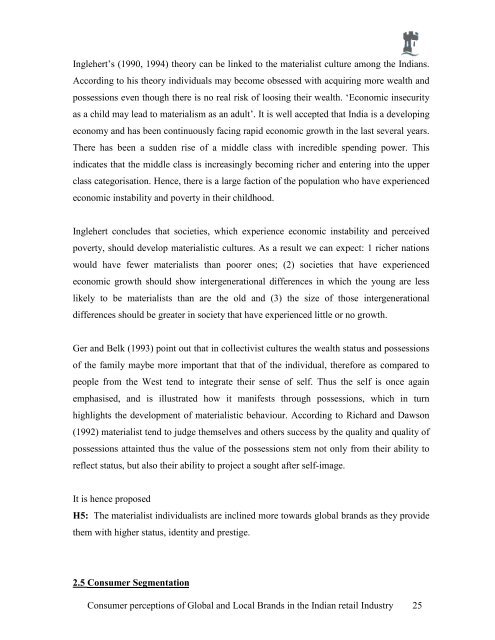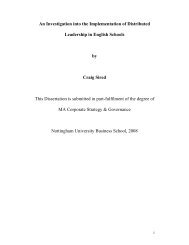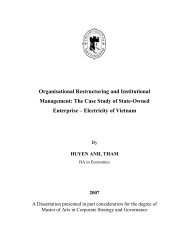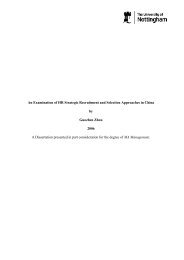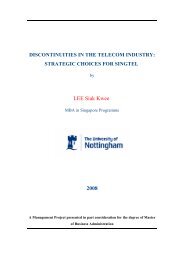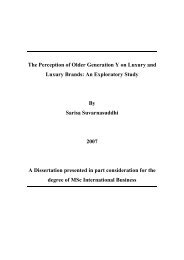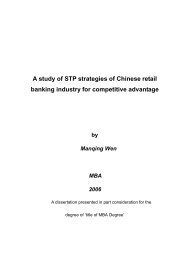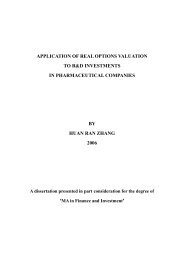âConsumer Perceptions of Global and Local Brands in the Indian ...
âConsumer Perceptions of Global and Local Brands in the Indian ...
âConsumer Perceptions of Global and Local Brands in the Indian ...
Create successful ePaper yourself
Turn your PDF publications into a flip-book with our unique Google optimized e-Paper software.
Inglehert’s (1990, 1994) <strong>the</strong>ory can be l<strong>in</strong>ked to <strong>the</strong> materialist culture among <strong>the</strong> <strong>Indian</strong>s.Accord<strong>in</strong>g to his <strong>the</strong>ory <strong>in</strong>dividuals may become obsessed with acquir<strong>in</strong>g more wealth <strong>and</strong>possessions even though <strong>the</strong>re is no real risk <strong>of</strong> loos<strong>in</strong>g <strong>the</strong>ir wealth. ‘Economic <strong>in</strong>securityas a child may lead to materialism as an adult’. It is well accepted that India is a develop<strong>in</strong>geconomy <strong>and</strong> has been cont<strong>in</strong>uously fac<strong>in</strong>g rapid economic growth <strong>in</strong> <strong>the</strong> last several years.There has been a sudden rise <strong>of</strong> a middle class with <strong>in</strong>credible spend<strong>in</strong>g power. This<strong>in</strong>dicates that <strong>the</strong> middle class is <strong>in</strong>creas<strong>in</strong>gly becom<strong>in</strong>g richer <strong>and</strong> enter<strong>in</strong>g <strong>in</strong>to <strong>the</strong> upperclass categorisation. Hence, <strong>the</strong>re is a large faction <strong>of</strong> <strong>the</strong> population who have experiencedeconomic <strong>in</strong>stability <strong>and</strong> poverty <strong>in</strong> <strong>the</strong>ir childhood.Inglehert concludes that societies, which experience economic <strong>in</strong>stability <strong>and</strong> perceivedpoverty, should develop materialistic cultures. As a result we can expect: 1 richer nationswould have fewer materialists than poorer ones; (2) societies that have experiencedeconomic growth should show <strong>in</strong>tergenerational differences <strong>in</strong> which <strong>the</strong> young are lesslikely to be materialists than are <strong>the</strong> old <strong>and</strong> (3) <strong>the</strong> size <strong>of</strong> those <strong>in</strong>tergenerationaldifferences should be greater <strong>in</strong> society that have experienced little or no growth.Ger <strong>and</strong> Belk (1993) po<strong>in</strong>t out that <strong>in</strong> collectivist cultures <strong>the</strong> wealth status <strong>and</strong> possessions<strong>of</strong> <strong>the</strong> family maybe more important that that <strong>of</strong> <strong>the</strong> <strong>in</strong>dividual, <strong>the</strong>refore as compared topeople from <strong>the</strong> West tend to <strong>in</strong>tegrate <strong>the</strong>ir sense <strong>of</strong> self. Thus <strong>the</strong> self is once aga<strong>in</strong>emphasised, <strong>and</strong> is illustrated how it manifests through possessions, which <strong>in</strong> turnhighlights <strong>the</strong> development <strong>of</strong> materialistic behaviour. Accord<strong>in</strong>g to Richard <strong>and</strong> Dawson(1992) materialist tend to judge <strong>the</strong>mselves <strong>and</strong> o<strong>the</strong>rs success by <strong>the</strong> quality <strong>and</strong> quality <strong>of</strong>possessions atta<strong>in</strong>ted thus <strong>the</strong> value <strong>of</strong> <strong>the</strong> possessions stem not only from <strong>the</strong>ir ability toreflect status, but also <strong>the</strong>ir ability to project a sought after self-image.It is hence proposedH5: The materialist <strong>in</strong>dividualists are <strong>in</strong>cl<strong>in</strong>ed more towards global br<strong>and</strong>s as <strong>the</strong>y provide<strong>the</strong>m with higher status, identity <strong>and</strong> prestige.2.5 Consumer SegmentationConsumer perceptions <strong>of</strong> <strong>Global</strong> <strong>and</strong> <strong>Local</strong> Br<strong>and</strong>s <strong>in</strong> <strong>the</strong> <strong>Indian</strong> retail Industry 25


